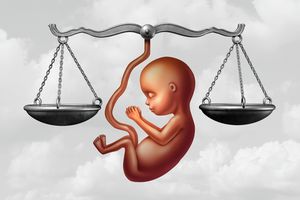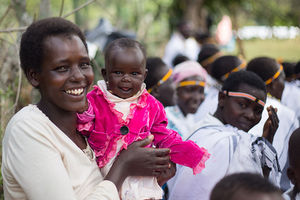
Researchers say diarrhoea, pneumonia and malaria are major killers, especially in areas in the country with limited access to healthcare and sanitation.
As we walk into Mama Lucy Kibaki Hospital in Nairobi, Agatha Atieno, 28, is seated on a bench with tears rolling down her cheeks.
“All I wanted was to hold my eight-month-old baby in my arms and watch him blossom in to a fine man who would maybe contribute to making Kenya a better place,” she tells the Nation.
But this was not to be. The previous day at around midnight, he suddenly couldn’t breathe and so she rushed him to hospital but he was pronounced dead on arrival.
“His breathing problems have been on and off, I did not know what to do,” she said.
The young mother is not alone. Scientists have this week found that most Kenyan children under the age of 5 years are dying from hypoxia, a condition where the body or a specific tissue does not receive enough oxygen. This is according to data from a peer-reviewed study done by the Child Health and Mortality Prevention Surveillance (CHAMPS), a global health surveillance programme run by Emory University, in partnership with the Kenya Medical Research Institute (Kemri) among other partners.
The 2025 study using data from public and private health facilities across the country was released on Friday. From the 998 dead children sampled, 362 were found to have succumbed to hypoxia This means that one in every three children lose their lives to hypoxia, which can happen due to various reasons — including low blood oxygen levels (hypoxemia), reduced blood flow, or problems with breathing or ventilation.
Hypoxia, they highlight, can be acute (sudden) or chronic (long-term) and can have serious consequences, including confusion, rapid heart rate, difficulty breathing, and potentially even death.
The new findings further show that out of the sampled 998 bodies, other leading causes of death are malnutrition (98), malaria (88), neonatal preterm birth complications (79), lower respiratory infections (43), congenital birth defects (43), neonatal sepsis (41), HIV (35), diarrhoeal diseases (33), Sepsis (31), neonatal aspiration syndromes (25) and other respiratory diseases (25).
The children, who died as a result of sickle cell disease were 15, while 12 died of congenital infection, and 10 from neonatal disorders.
Researchers also noted that the causes of death in 20 children from their sample could not be established in the remaining 28 dead children lost their lives as a result of injury, cancer, maternal factors, nutritional deficiencies, other infections among other reasons.
“The results of this study demonstrate the potential of the minimally invasive tissue sampling tool to reliably investigate causes of child deaths and highlight the significant role of infections in high-child-mortality settings, providing concrete opportunities for action to enhance child survival,” the researchers said.
They noted that the number of deaths of children younger than 5 years has been steadily decreasing worldwide, from more than 17 million annual deaths in the 1970s to an estimated 5.3 million in 2019.
The experts say a more detailed characterisation of childhood deaths could inform interventions to improve child survival.
“CHAMPS Network conducts childhood mortality surveillance in sub-Saharan Africa and South Asia using innovative post-mortem minimally invasive tissue sampling (MITS). In this cross-sectional study, MITS was conducted in deceased children aged 1 to 59 months,” they explained and added that their expert panel attributed underlying, intermediate, and immediate conditions in the chain of events leading to death, based on histopathologic analysis, microbiological diagnostics, clinical data, and verbal autopsies.
Speaking to the Nation on Friday, Prof Elijah Songok, the acting director-general at Kemri, said over the past decade, CHAMPS has fundamentally reshaped the global understanding of what causes stillbirths and under-five child mortality using innovative diagnostics, MITS, and rigorous surveillance methods.
“This kind of precision health data is not just timely—it is lifesaving,” Prof Songok said.
The Director-General at the Ministry of Health Patrick Amoth underscored the importance of translating such evidence into policy and action.
“Data without action is a missed opportunity. CHAMPS gives us the evidence we need to allocate resources more effectively, prioritise interventions, and ensure that our policies are informed by what truly affects child survival,” he said.
Dr Cynthia Whitney, the executive director of the CHAMPS Programme Office at Emory University, explained that CHAMPS, supported by the Gates Foundation, aims to increase understanding of the causes of stillbirths and death in children under five, enabling scientists and public health leaders to take action.
Findings are shared with affected families, communities and public health leaders to improve healthcare, policies and programs that can save lives,” she said.
But why are children dying in the first place?
According to the researchers, diarrhoea, pneumonia and malaria are major killers, especially in areas in the country with limited access to healthcare and sanitation. At the same time, many public health facilities are not well-equipped to handle the cases and have no medication such as a constant supply of medical oxygen.
The World Health Organization (WHO), in a recent report, says “the leading causes of death in children under 5 years are preterm birth complications, birth asphyxia/trauma, pneumonia, diarrhoea and malaria, all of which can be prevented or treated with access to affordable interventions in health and sanitation.”
Speaking last month during World Health Day commemorations, Dr Chikwe Ihekweazu, acting WHO Regional Director for Africa said that the World Health Assembly resolution 77.5 calls for accelerated action in reducing maternal and child mortality.
“In too many places, pregnancy and childbirth are still life-threatening events. But it doesn’t have to be this way, every dollar invested in maternal and newborn health delivers major returns: healthier families, stronger societies and sustainable economic growth,” the WHO official said.
The acting regional director pointed out that the key barriers to progress include inadequate financing, weak governance, health workforce shortages and recurring shocks, such as disease outbreaks and conflicts, all of which disrupt maternal and child health services.
In fragile and crisis-affected settings, women and children are particularly at risk, he added.
“Among newborns, preterm births, complications during childbirth, sepsis and neonatal infections, as well as congenital anomalies are the common causes of deaths,” Dr Chikwe said, further noting that WHO is supporting countries across the region in implementing a wide range of interventions.
These, WHO explains, include developing and rolling out maternal and newborn health acceleration plans and implementing antenatal and postnatal care guidelines.
Other priorities include increasing access to skilled health personnel at birth and emergency obstetric care, expanding special care for small and sick newborns, and tackling the social and economic drivers of health inequities.
“More than 60 percent of countries in the African region now report that over 80 percent of births are attended by skilled health personnel, a significant improvement from just 28 percent in 2010. However, progress varies across the region, with rural and crisis-affected areas continuing to face acute service shortage gaps,” the global health regulator urges.






